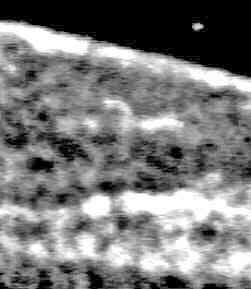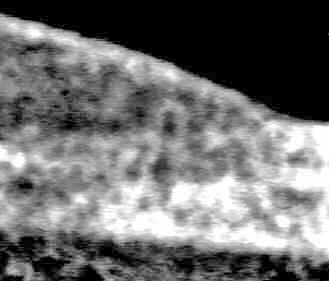|
by Steve Troy from LunarAnomalies Website
In July at the Enterprise Mission Phoenix event, Richard Hoagland asked me and independent Lunar researcher Steve Troy to join our efforts. Steve has been quietly working to confirm Hoagland’s artificial Lunar anomalies hypothesis for almost 2 years. Steve’s approach is entirely analog, sifting through the reams of data and catalogs provided by a variety of NASA archives.
He is finding numerous anomalies and discrepancies in his
studies, both with regard to the unnatural "geology" and the also
with the photo’s themselves. I was asked to provide image
enhancement and confirmation of Steve’s findings using standard
digital techniques.
While Steve and I have noted
the "arches" and plan to work on them later, we are focused on
another part of 4421. Assuming others may be examining this frame,
we have decided to post our preliminary results so that the other
researchers may cross confirm our findings as well. Richard Hoagland
concurs with this decision.
AS10-30-4421 From 5 X 7 Sectional
This is an unenhanced scan of Steve’s original analog photo of
AS10-30-4421. He first noticed the very bright area in the right
center of the image. A quick examination of the 8 X 10 print showed
that this area has the highest albedo in the entire photograph.
However, in the far right portion of the frame there is an anomalous object several magnitudes brighter than any other feature in this picture. It is also brighter than any other natural or anomalous formation in the series 4414-4420. With an 8X lupe and a light table one can see - upon examining sectionals of this area - a transparent, Dome-like shape that apparently is along the north Maria edge. Its transparency is confirmed by tracing the mountains behind the object, which are visible through this immense dome like shape.
I obtained other views of this area and am currently looking at the whole Apollo Crisium "Series" with Mike Bara.
NSSDC has been most cooperative in responding to this as well as all photo neg requests.
AS10-30-4421 image map. Picard is the crater just to the lower center of the frame.
Cleomedes F and
Cleomedes Fa are just to the
right of the image edge. 4421 in is an oblique image taken at high sun from an altitude of 60km. On vertical shots from Lunar Orbiter 4 (191H3 and north Crisium close up, 51-H3) this bright "Dome" can’t be seen.(2) The Apollo 10 footprint maps show the angle of the photo. Comparative angles overlaid on the Lunar Orbiter photos as well as some Apollo 17 shots of the area show no such anomaly. It is my belief that the dome must be seen at the right sun angle due to its transparency and possible crystalline composition.
On the Lunar Orbiter 4 photos one can see a small bright ray crater that it is situated just inside the right 4421 footprint map photo boundary. The dome seen on 4421 could not be this crater reflection because it is higher than the mountains that tower over this region separating the northern Crisium highlands & the maria.
The mountains,
Scale must therefore be
considered when looking at this feature which is estimated to rise 3
to 4 miles vertically and 10-15 miles horizontally from the maria
floor area.
Footnotes:
Immediately to the right of this bright object is a faint cross-like object jutting from the hillside, and an odd spire or antenna seeming to rise from the left slope of the main dome.
I also believe there is a second dome just beyond the right edge of the main dome. It’s contour is visible through the body of the main dome. It is more opaque from the perspective of 4421 than is the main dome, and the area where it overlaps the main dome is the area of brightest albedo.
This would be explained by the light sources of the two domes adding their brightness as they reflected the sunlight into the camera. I believe there is a possibility that the image map is in error and that the twin domes are in fact covering the craters Cleomedes F and Cleomedes Fa.
If this is correct, then the craters are in fact not "craters" at all.
Curiously, the entire image seems to be oddly blurred, as if there
were some fuzzy "Stuff" between the camera and the north shore of
Mare Crisium. Upon viewing these characteristics of 4421 on my light
board I immediately began a series of image enhancements.
I was quite frankly stunned by what these revealed.
Under enhancement, the less distinct left edge of the Main Dome became more clearly defined, and this helps to determine it’s location in front of the mountain chain along the North shore.
The now familiar translucent material is also seen to be intervening between the camera and the domes, accounting for much of the fuzzy quality and odd mottling apparent on the frame. Some have asserted that this pattern is an artifact of the JPEG compression process, however, the original data was from TIFF images which do not suffer from this "tile" effect.
This intervening material is also
consistent with Richard Hoagland’s assertion of a box like "dome"
over the entire Crisium region (Martian Horizons - The Journal of the
Mars Mission, Vol2, No.5, Frame AS16-121-19438). The Dome also
appears to have a cellular structure identical to the "Castle", and
the "Tower" seen in the famous Hoagland data.
It is also isolated in the sense that there are no other obvious "Faces" along the length of the North Shore visible in this image. This strongly suggests that it is a genuine feature rather than a collection of random bright and dark spots in the image.
The "Face" is also situated on the hillside overlooking the "Dome", in such a way as to look down directly into the center of the main "Dome".
Richard Hoagland has strongly cautioned me about the tendency to see
faces everywhere, but it is important to understand that I am not
suggesting that this object resembles a face, but rather I am
comparing it more precisely to
the Face on Mars at Cydonia. Given
the "headdress" and other features I believe it compares favorably
to the Cydonian structure.
Using this system, I propose that this "Crisium Face" is a
Type II.
We will pursue other images in an attempt to verify details.
The "Phoenix" is an odd cross shaped appendage rising from the hillside next to the "Face". It is constructed of 2 cylindrical objects interlocking with the vertical cylinder bending over to the left, giving the impression of a bird with wings outstretched in flight. I have no idea what this object might represent but it stands out dramatically from the drab mountain chain it rests on and bears no resemblance to any explainable Lunar geology.
It reflectivity suggests a metallic or crystalline construction. This is reinforced by the fact that such a rounded surface would not reflect this much light if were made of typical "highland" material.
Note that it is nearly as bright as the "Dome" in front of it, which
we have already established is made from a translucent glass like
material.
The "Bowling Pin" is a dark bulbous object just to the right of the "Phoenix" which actually seems to protrude through the main "glass Dome". This appears to be an antenna of watch tower of some kind, and it’s middle portion is definitely obscured by the glass like material of the "Dome" itself. Note how the upper tip of the "Bowling Pin" is encased in the same glass like material and blots out the upper rim of the "Dome" behind it.
Again, a spike like
object such as this has no place in standard Lunar geology, and I am
at a complete loss to explain it as anything but artificial.
False Color Enhancement
Again note the geometric "haze" above the horizon and the cellular structure of the 2 overlapping domes.
I must therefore
conclude that they are all likely constructs.
|


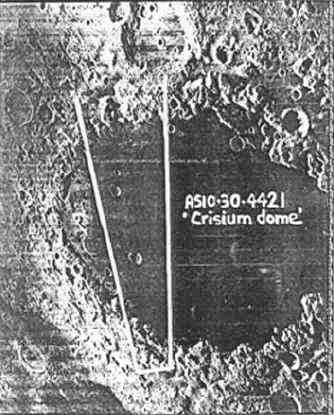
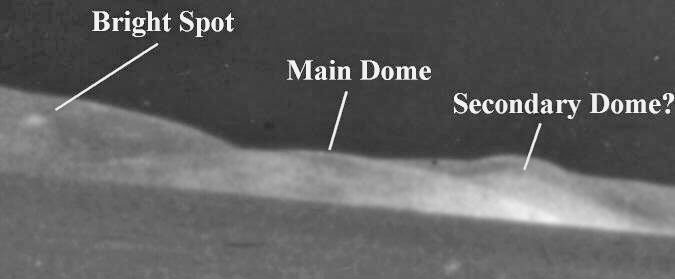
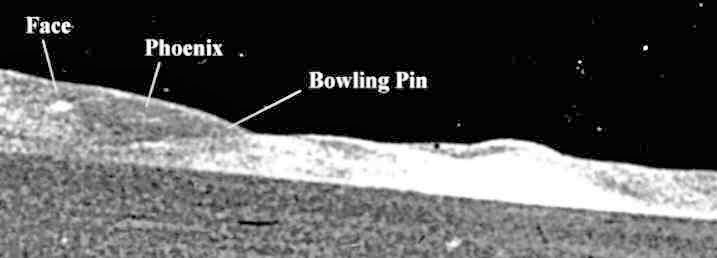
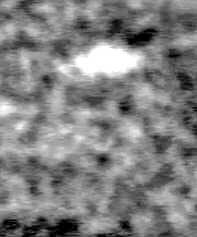 The "Face", despite being somewhat distorted by the semi-translucent
material intervening between the camera and the object, displays all
the necessary characteristics to be included as a potential
monument. It has bilateral symmetry, a defined "Nose" "Mouth" and
"Eye-Sockets", and a proximity to other highly anomalous objects.
The "Face", despite being somewhat distorted by the semi-translucent
material intervening between the camera and the object, displays all
the necessary characteristics to be included as a potential
monument. It has bilateral symmetry, a defined "Nose" "Mouth" and
"Eye-Sockets", and a proximity to other highly anomalous objects. 